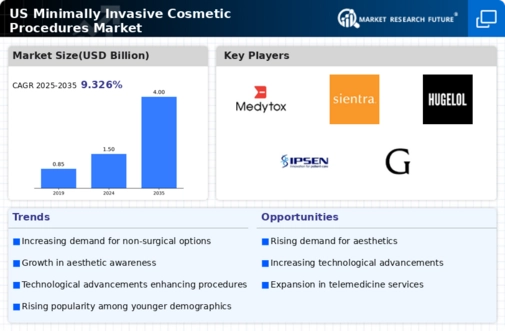Growing Aging Population
The growing aging population in the US is a significant driver of the minimally invasive-cosmetic-procedures market. As individuals age, they often seek ways to maintain a youthful appearance, leading to increased demand for non-surgical options. Projections indicate that by 2030, approximately 20% of the US population will be over 65 years old, creating a substantial market for age-related cosmetic procedures. This demographic shift suggests a potential increase in the market size, as older adults are more likely to invest in treatments that offer visible results without the risks associated with invasive surgeries. The focus on maintaining a youthful look among this population segment is likely to propel the growth of the minimally invasive-cosmetic-procedures market.
Increased Awareness and Acceptance
There is a notable increase in awareness and acceptance of cosmetic procedures among the general population, which significantly impacts the minimally invasive-cosmetic-procedures market. Educational campaigns and social media platforms have played a crucial role in demystifying these treatments, making them more accessible and acceptable. Surveys indicate that nearly 60% of adults in the US are open to undergoing cosmetic procedures, reflecting a shift in societal norms. This growing acceptance is likely to encourage more individuals to consider minimally invasive options, further propelling market growth. As more people share their positive experiences online, the stigma surrounding cosmetic enhancements appears to diminish, fostering a more favorable environment for the industry.
Advancements in Product Formulations
Innovations in product formulations are transforming the landscape of the minimally invasive-cosmetic-procedures market. Newer, safer, and more effective products are being developed, which enhance the efficacy and safety of procedures. For instance, the introduction of longer-lasting fillers and advanced neurotoxins has expanded treatment options for consumers. The market for these advanced formulations is expected to grow significantly, with estimates suggesting a potential increase of 15% in the next few years. This trend not only attracts new clients but also retains existing ones, as patients seek the latest advancements in cosmetic treatments. The continuous evolution of product offerings is likely to be a driving force in the market's expansion.
Rising Demand for Aesthetic Procedures
The increasing societal emphasis on physical appearance appears to drive the growth of the minimally invasive-cosmetic-procedures market. As individuals seek to enhance their looks with less downtime, the demand for procedures such as Botox and dermal fillers has surged. Recent data indicates that the market is projected to reach approximately $5 billion by 2026, reflecting a compound annual growth rate (CAGR) of around 10%. This trend is particularly pronounced among younger demographics, who are increasingly opting for these procedures as part of their beauty regimen. The desire for quick, effective solutions without the need for extensive recovery time seems to be a key factor in this rising demand.
Influence of Social Media and Celebrity Culture
The influence of social media and celebrity culture on the minimally invasive-cosmetic-procedures market cannot be overstated. Platforms like Instagram and TikTok have become powerful tools for promoting aesthetic treatments, with influencers and celebrities showcasing their experiences. This visibility has led to a surge in interest, particularly among younger audiences who aspire to emulate their favorite personalities. Data suggests that nearly 40% of individuals aged 18-34 are motivated to pursue cosmetic procedures after seeing them on social media. This trend indicates a shift in how beauty standards are perceived, with social media acting as a catalyst for increased demand in the market. The interplay between celebrity endorsements and consumer behavior is likely to continue shaping the industry.
















Leave a Comment